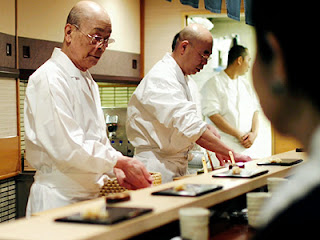Rachel Weisz (in a marvelous performance) is in deep
trouble. She has left her husband, who
loves her for her passion, a younger man who does not love her. Her despair in this triangle leads her to
attempt suicide. And this is just the
first ten minutes of The Deep Blue Sea.
The theme of the film is passion, and the consequences of
giving in to our passions. Passion is
gorgeous, but dangerous; it is powerful and destructive. Certainly it is shown in this film to be a
double-edged sword, ending in destruction.
Passion is often confused with love, especially among the
young. This is not to say that passion
isn’t an important aspect of love. Were
it not for passion, would our rational minds ever get married, get pregnant, go
through birth, raise children? Passion
gives us the energy and drive to accomplish that which our species most
needs. It is the engine that drives our
survival.
But is that all of love, or even the foundation of
love? Perhaps it is the engine, but what
is the hull, the keel, the sail? Passion
drives love, makes it do amazing stunts, but what keeps love afloat? If passion were all that love was made of,
love would look like a hyperactive boy, flitting this way and that, always
attached to a shiny object, running over whatever or whoever is in his
way. Although drawn out, this is
exactly what we see in The Deep Blue Sea—the destructiveness of passion, and
the ultimate loneliness of it.
It is interesting that within The Deep Blue Sea is embedded
the theme of a more recent film, Amour: “A lot of rubbish is talked about
love. You know what real love is? It’s wiping someone’s ass or changing the
sheets when they’ve wet themselves. And
letting them keep their dignity so you can both go on.”
Amour is about the slow demise of a wife and the faithful
service to do whatever was needed by her husband. She has a quiet stroke, almost unnoticeable. Then another, which leaves her half-paralyzed. She speaks of ending her life, but her
husband convinces her not to, that she is not a burden to him. As the movie wears on, she becomes more and
more of a burden as she regresses to an infant state. The performance by Emmanuelle Riva is easily
the bravest acting I have ever seen, allowing her to be put in the most
humiliating positions ever.
Just by its title, Amour asks “Where is love in this
couple?” Love isn’t found primarily in
the ending of the film, as some would say.
Love is found in the day-to-day faithfulness, awareness of the other’s
need, and spending oneself to meet that need.
As is often true, we can see love in contrast to those who do not
display it: the daughter who wants to push her own will because of her own emotional
needs, the nurse who has a program and will follow it no matter what the cost
to her patient.
Love is the dance of a couple moving to help her sit in a chair.
Love is spoon feeding a spouse when she doesn't want to eat, and learning to give up.
Love is giving her privacy so she doesn't have to inflict her misery upon others.
Love is a wife who is unable to communicate anything but “Hurts…
hurts…hurts…hurts… hurts” for hours, and a husband who stokes her hand, tells
her a story, sings old songs, until she quiets and is at peace.
Both films speak of the limits of love
as well. The Deep Blue Sea displays passion
as having a limited life, quick to begin and quick to end. The true love of Amour also has a limit: the
emotional demands of love takes an emotional toll and it eventually breaks into
rash anger. But the best love recognizes
that limitation and prepares for it, even apologizes for the limitations.
I wish I could recommend Amour as an example for all to
observe. But it is such a difficult
film, like almost all of Michael Haneke’s films, that I cannot recommend it to
everyone. My parents are so close to
this situation, that the example would only hurt them emotionally. Others are so young and passionate that Amour
would just seem dull and pointless. But for those who are ready for it, Amour is
the glory of love in its most raw display.
The Deep Blue Sea is more beautiful, and has wonderful performances we
can relate to. Amour takes us to the
next level of teaching us depth and maturity.








